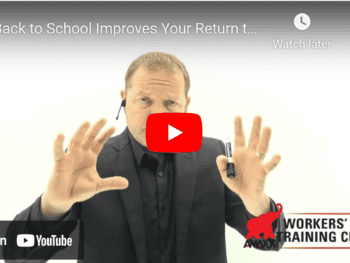Most employers realize a properly constructed return to work (RTW) program can have a major positive impact on the cost of workers compensation.
The question we often hear is “Okay, we want a successful return to work program, but how is it done?”
Achieving a proficient return to work program requires EFFORT on the part of the employer beyond placing the injured employee back into his/her previous job with instructions “not to pick up anything heavy.”
A properly constructed RTW program must be integrated into the overall loss management program; an effective transitional duty program and early return to work program.
Effort requires following these key points:
22 Key Points in Constructing a RTW Program
1. Immediate reporting of all accidents.
2. Immediate medical intervention including nurse triage.
3. Prompt investigation of the accident.
4. Regular and on-going contact with the employee.
5. The proper selection of the treating physician (where allowed by statute).
6. Each transitional duty position is reviewed on a weekly basis (to give the employer the flexibility to withdraw the RTW offer if it is not working out).
7. The transitional duty positions have a time limit of 30 to 90 days depending on the nature and severity of the injury. (WCxKit)
8. A written policy outlining what is required of the employee, the employee’s supervisor and the employee’s department.
9. Identification of appropriate lost time alternative positions matching the employee’s medical capabilities.
10. A team effort between the employer, the employee and the medical provider.
11. As the employee improves medically and capabilities improve, the transitional duty position should be flexible to allow the employee to do more work.
12. Utilization of the employees’ suggestions on how they can do more work while on transitional duty.
13. Active involvement of the nurse case manager in customizing the transitional duty work to the medical restrictions.
14. The transitional duty position provides work that is meaningful and productive.
15. There is customization of the transitional duties for each injured employee.
16. The modified duty position matches the worker’s capabilities and medical restrictions established by the medical provider.
17. The transitional duty position allows for a progression in the employee’s physical abilities.
18. The employee knows the new duties are transitional duties and will not be a permanent new job description.
19. The transitional duty is designed to return the injured employee to the full-time duties in a productive and safe manner.
20. The transitional duty permits the injured employee to work partial days, if needed, and progress to full-time work.
21. The transitional duty does not interfere with the employee attending medical treatment for the workers comp injury.
22. The employee’s supervisor, manager and department are not penalized if the injured employee’s production is lowered than the production of a non-injured employee. (WCxKit)
Take a deep breath because you’ve only started… There are a few more very important steps to take before your RTW plan is set and you, the employer, are actually saving money and, just maybe, seeing a reduction in your “mod.”
Author Rebecca Shafer, JD, President of Amaxx Risks Solutions, Inc. is a national expert in the field of workers compensation. She is a writer, speaker and website publisher. Her expertise is working with employers to reduce workers compensation costs, and her clients include airlines, healthcare, printing/publishing, pharmaceuticals, retail, hospitality and manufacturing.
Contact: RShafer@ReduceYourWorkersComp.com
ESSENTIAL: This article is Return-to-Work Essentials content.
Do not use this information without independent verification. All state laws vary. You should consult with your insurance broker or agent about workers comp issues.
©2010 Amaxx Risk Solutions, Inc. All rights reserved under International Copyright Law. If you would like permission to reprint this material, contact Info@WorkersCompKit.com.
















